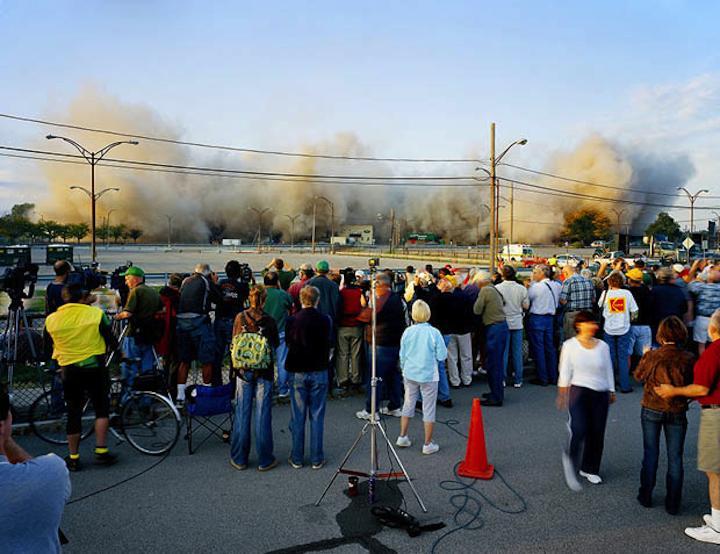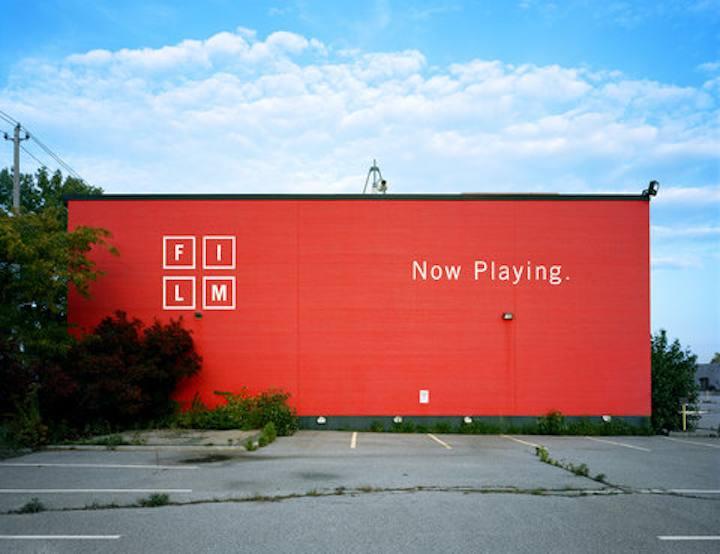Robert Burley at Ryerson Tonight
Since 2005, photographer and photography lecturer Robert Burley has been documenting the demise of film photography through film photographs. He has traveled around the world with his 4×5 field camera, capturing the demolition of buildings, the equipment that once powered a giant industry, and the desolation of factories that were once teeming with workers.
In his book, The Disappearance of Darkness: Photography at the End of the Analog Era (Princeton Architectural Press), he writes of the event that, more than any other he witnessed, encapsulates the demise of the industry’s vortex—the Eastman Kodak Company:
On a gray December morning in 2007, crowds gathered to watch the death of photography in its birthplace, in Rochester.New York. But photography refused to go quietly. After the demolition team had set off the explosives placed at the base of the building, only a portion of the structure came down. An embarrassed group of Kodak executives were forced to schedule a second attempt in February of 2008, which successfully ended the company’s presence in Rochester.
 Robert Burley, A crowd
watching the implosions of buildings 65 and 69 at Kodak Park in Rochester, New York, 2007. © Robert Burley.
Robert Burley, A crowd
watching the implosions of buildings 65 and 69 at Kodak Park in Rochester, New York, 2007. © Robert Burley.
In the book, Burley writes: To be in attendance at [the demolition of Buildings 65 and 69] was to experience something thrilling and disheartening at once. The thrill came from the deafening explosions and the unreal collapse, only taking seconds, of an enormous and cavernous building. This was invariably followed by an eerie silence; spectators, many of whom were former employees and had spent the better part of their lives working in these buildings, quietly got into their cars and went home. In each instance, I believe, I was one of the few photographers recording the event on film. When I looked into the crowds in front of my view camera, I saw an array of digital devices—cell phones, camcorders, and cameras—capturing a final “Kodak moment.”
The Waltham [Massachusetts] facility was closed in 2008 when Polaroid, after its second bankruptcy in ten years, announced that it would discontinue the production of all its instant films. Once having employed more than 15,000 people in Massachusetts, the Polaroid Corporation was reduced to a workforce of 1,500 by 2010, offering a variety of digital products, including camcorders, DVD players, and LCD screens. In 2011, it announced the production of a digital version of its instant camera.
 Robert Burley, Former Toronto Film
Studios, proposed site of a new Walmart, Toronto, 2011. © Robert Burley.
Robert Burley, Former Toronto Film
Studios, proposed site of a new Walmart, Toronto, 2011. © Robert Burley.
Burley also visited, and photographed, the Impossible Project in the headquarters of the rundown Polaroid manufacturing plant in Enschedein the Netherlands, a business that rose from the ashes to serve a small but loyal consumer base that continues to use Polaroid film and cameras.
Burley shared this information with David Gonzalez for Lens Blog last winter: The project began in 2005, when he learned that Kodak Canada — which he noted produced all the black-and-white film for North America — was going to close. His first thought was whether someone would photograph that moment. Relying on contacts there — culled from years working with the company on a lecture series — he gained entry to places that by definition had to control access as they manufactured film that, in the case of color, required more than a dozen layers of hair-thin emulsion.
Mr. Burley had less luck with Kodak in Rochester, although he was allowed to photograph several factory implosions there. “They would let me through 6 of the 10 doors,” he said. “But once I got to No. 7, they said, ‘No, you can’t go in there.’ They don’t want their competitors to see how they’re doing things. It is still a world of secret recipes.”
Tonight, the exhibition Robert Burley | The Disappearance of Darkness opens at the Ryerson Image Centre in Toronto from 6-8 pm. 33 Gould Street, Toronto, ON. The exhibition continues through April 13. Information.
Burley recently sat down for an interview with Steve Paikin on TVO's The
Agenda to discuss his work capturing the collapse of film photography and the medium's transition from film to digital. View the interview here. View Robert Burley’s blog here.
Also see the New York Public Library blog re: Burley's talk with Alison Nordström, Senior Curator of Photographs at the George Eastman House here.


